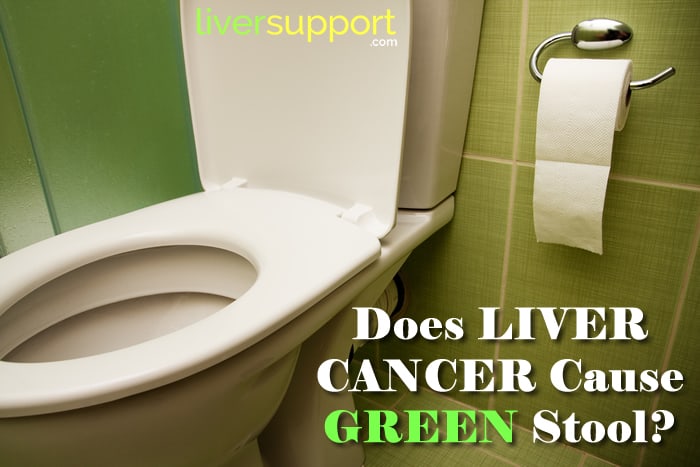
Previous
8 Things You Need to Know About Pregnancy, Liver Disease and Liver Fibrosis

Next
Does Liver Disease Treat Men and Women Equally?
Does Liver Cancer Cause Green Stool?
Sometimes the color and shape of your stool is cause for concern, either due to liver disease or some other health matter. Find out what it means when your stool is green.
While having your regular morning or afternoon (or whenever you like to go) bowel movement, from time to time, you’re bound to take a look in the toilet bowl and be surprised by the color or shape of your stool and wonder if everything is okay.
Sometimes it’s different than the usual brown or green color, other times the shape and size may be different than the usual log.
Most of the time, these variations are okay and simply due to changes in your diet or activity.
But, sometimes, it may be a cause for concern, either due to liver disease or some other health matter.
The following will tell you if you have anything to worry about or if you can just flush your worries away.
How Should a Normal Stool Appear?
- A healthy stool usually appears in most shades of brown and some shades of green (more on this below).
- It should be several inches long with a log shape due to its formation within the intestines. Sometimes it could be longer or larger, but that should not be cause for alarm.
- Anywhere between a firm and soft consistency is pretty standard. If it sways either way, it may suggest some issues with digestion or fiber content.
- The usual movement should be easy to pass and take only a minute to push out. But some people do spend a bit more time on the toilet so, as a general rule, a bowel movement should take no more than 10 to 15 minutes.
On average, a person with healthy digestion will have a bowel movement anywhere between every other day to three times a day. Any less may suggest possible constipation. In this situation, you should drink more water to help it pass.
If your stool is floating, it means that it is less dense than the others that sink. It may be due to an increased amount of gas or water, as one study found.
Malabsorption may also be responsible for the stool floating. In this situation, you may be experiencing slight constipation or other abnormalities.
Different Colors

As already mentioned, it is standard for your stool to appear in various shades of brown or green. But sometimes it may appear to be a different color. This is usually just attributed to your diet and nothing to be concerned about. Although, other times, you may want to consult a physician.
The color is primarily influenced by diet and bile content in your stool. As bile pigment progresses through your gastrointestinal tract, their chemicals are altered by enzymes, changing the pigments from green to brown.
The 5 different types of colors and the potential causes for them are listed below:
- Green – Food might be passing through your large intestine at too quick of a pace. Possibly due to diarrhea. This could lead to bile not having time to fully breakdown.
Dietary Cause: Green leafy vegetables, green food coloring, such as in flavored drink mixes or popsicles, iron supplements. - Light-colored, white or clay-colored – Lacking bile in stool. Could indicate obstruction of bile duct.
Dietary Cause: Some medications, including large doses of bismuth subsalicylate (Kaopectate, Pepto-Bismol) and other anti-diarrheal drugs. - Yellow, greasy, foul-smelling – Excessive amounts of fat in the stool, such as due to a malabsorption disorder like celiac disease.
Dietary Cause: Sometimes the protein gluten, usually found in wheat products, including breads and cereals. Consult a doctor for evaluation. - Black – Blood in the upper gastrointestinal tract, such as the stomach.
Dietary Cause: Iron supplements, bismuth subsalicylate (Kaopectate, Pepto-Bismol), black licorice. - Bright Red – Blood in the lower intestinal tract, such as the large intestine or rectum, often from hemorrhoids.
Dietary Causes: Red food dye, beets, cranberries, tomato-based liquids, red gelatin or drink mixes.
Different Shapes
Outside of the usual log shape, your stool can take other forms. The Bristol Stool Chart breaks up these shapes and sizes into 7 different categories:
Type 1 – Hard and separate little pellets with an appearance similar to nuts. Usually hard to pass and a strong indicator of constipation.
Type 2 – Lumpy log shaped stool. This is also usually an indicator of constipation.
Type 3 – Log shaped with cracks on the surface. This is the standard stool that should pass with ease.
Type 4 – A smooth snake-like stool. It’s another normal form that should happen every one to three days.
Type 5 – This smaller form is similar to type 1 but easier to pass and have more clear cut edges. Usually indicative of lacking fiber in your diet.
Type 6 – Has a fluffy and mushy appearance with ragged edges. Usually a sign of mild diarrhea. Drinking more water or fruit juice will help improve it.
Type 7 – When it’s completely water with no solid pieces. This is diarrhea. Bowels are moving too quickly to form a solid stool.
What Color Is Your Stool if You Have Liver Problems?
When it comes to liver problems, there are primarily two colors you want to keep an eye out for.
- Pale/White – If your liver is not producing enough bile, or if the flow of the bile is blocked and not draining from your liver, your stools may become pale or clay-colored. This is known as cholestasis. Having pale or clay-colored stools from time to time may not be an issue. However, if frequent, you may have a serious illness. You should meet with a physician whenever you have pale or clay-colored bowel movements in order to rule out illness and disease.
- Black/Tarry – This is a symptom of Esophageal varices which are dilated blood vessels within the walls of the lower part of the esophagus that are prone to bleeding. They can appear in people suffering from severe liver disease. A diseased liver can lead to high blood pressure in the portal vein which supplies blood to your liver. Over time, the increased blood pressure will cause vessels to enlarge, becoming collateral blood vessels. They act as a means to divert blood under high pressure. The extra pressure causes them to dilate and become twisted. This can eventually cause the lower esophagus and stomach to rupture, leading to significant losses of blood and vomiting.
So, Does Liver Cancer Cause Green Stool?
Liver cancer is not known to cause a green stool. Like other liver diseases, white/pale colored stools are a sign of liver cancer. Having said that, sometimes when cancer patients undergo a donor bone-marrow transplant they may develop graft-versus-host disease, which is marked by a number of gastrointestinal symptoms, including watery, green diarrhea, according to the National Cancer Institute.
When to See a Doctor

If any less urgent, abnormal bowel habits carry on for several days, you should speak to a physician. A green or hard stool from time to time is nothing to worry about. When irregularities carry on for more than a few days, you should take action and meet with a healthcare professional.
This also includes the less concerning conditions, like changes in color or consistency, or constipation.
Most seriously, chronic constipation can block the bowels, while chronic diarrhea can make it difficult for someone to absorb necessary nutrients from food. Both chronic constipation and chronic diarrhea may be signs of more serious conditions. The first sign of either of these should not be immediate cause for concern, but be cognizant of it and see if it changes over the next few days.
Biggers, Alanna. “How Many Times Should You Poop a Day: Factors and Frequency.” Healthline, Healthline Media, 12 Sept. 2017, www.healthline.com/health/how-many-times-should-you-poop-a-day.
“Bristol Stool Chart.” Overactive Bladder - a Falls Risk • Continence Foundation of Australia, Continence Foundation of Australia, 2017, www.continence.org.au/pages/bristol-stool-chart.html.
“Common Characteristics of Liver Disease.” Is There Really Any Benefit to Multivitamins?, John Hopkins Medicine, www.hopkinsmedicine.org/healthlibrary/conditions/liver_biliary_and_pancreatic_disorders/common_characteristics_of_liver_disease_85,P00664.
Mayo Clinic Staff. “Constipation.” Mayo Clinic, Mayo Foundation for Medical Education and Research, 10 Jan. 2018, www.mayoclinic.org/diseases-conditions/constipation/symptoms-causes/syc-20354253.
“Graft Versus Host Disease (GvHD).” Cleveland Clinic, 14 Feb. 2014, https://my.clevelandclinic.org/health/diseases/10255-graft-vs-host-disease-an-overview-in-bone-marrow-transplant.
Herrine, Steven K., and Sidney Kimmel. “Cholestasis - Liver and Gallbladder Disorders.” Merck Manuals Professional Edition, May 2018, www.merckmanuals.com/home/liver-and-gallbladder-disorders/manifestations-of-liver-disease/cholestasis.
Kerr, Michael, and Jacquelyn Cafasso. “Malabsorption Syndrome.” Healthline, 23 May 2017, www.healthline.com/health/malabsorption.
Levitt, Michael D., and William C. Duane. “Floating Stools - Flatus versus Fat | NEJM.” New England Journal of Medicine, 4 May 1972, www.nejm.org/doi/full/10.1056/NEJM197205042861804.
Luo, Elaine K. “Chronic Diarrhea.” Healthline, 25 Sept. 2017, www.healthline.com/health/diarrhea/chronic-diarrhea.
Luo, Elaine K. “Chronic Constipation: What Your Gut Is Trying to Tell You.” Healthline, 30 July 2018, www.healthline.com/health/cic/what-your-gut-is-trying-to-tell-you.
Picco, Michael F. “Stool Color: When to Worry.” Mayo Clinic, Mayo Foundation for Medical Education and Research, 3 Nov. 2018, www.mayoclinic.org/stool-color/expert-answers/faq-20058080.
Sullivan, Debra. “Poop and You.” Healthline, 6 July 2018, www.healthline.com/health/digestive-health/types-of-poop.






